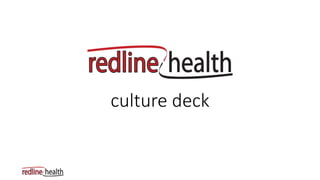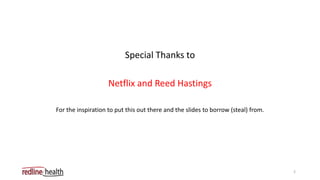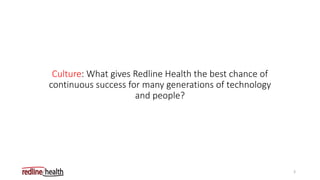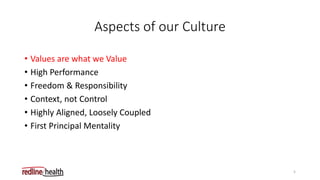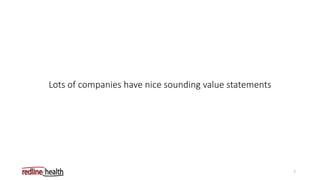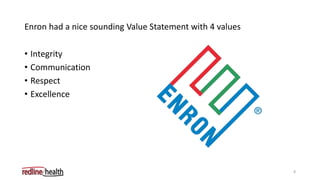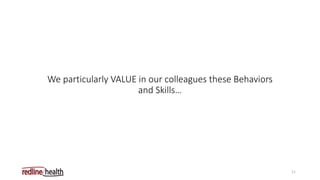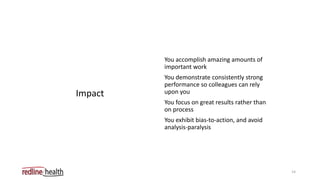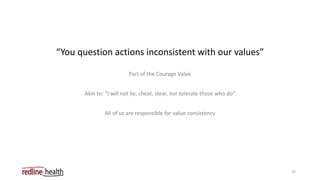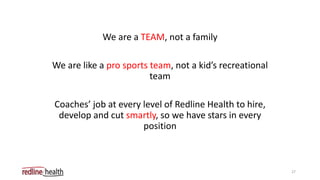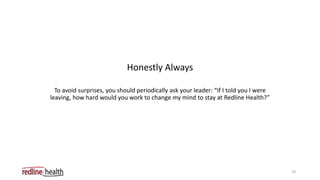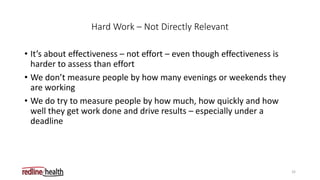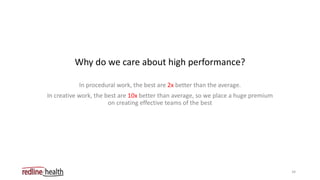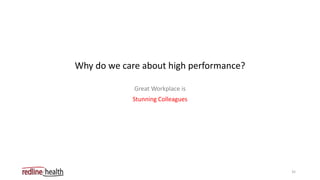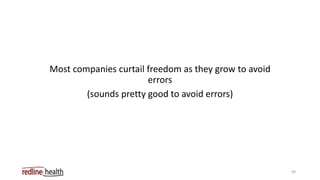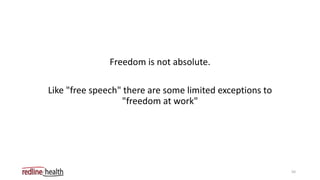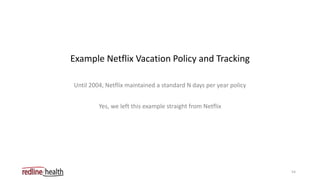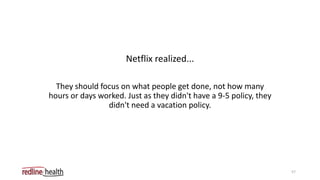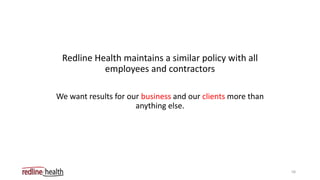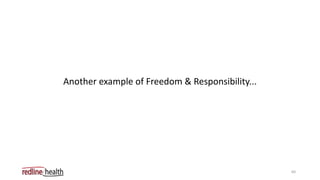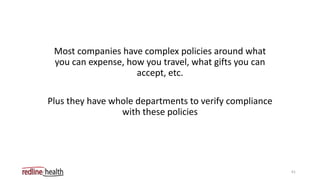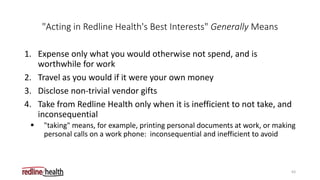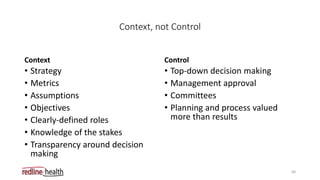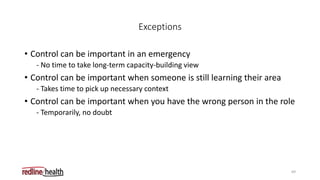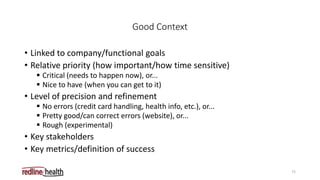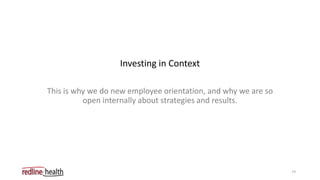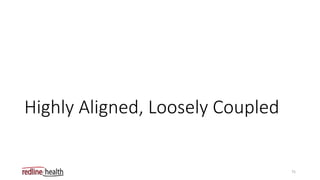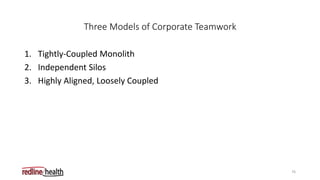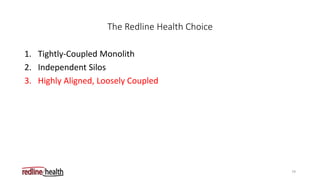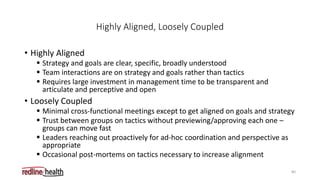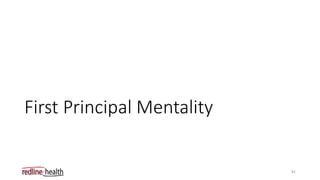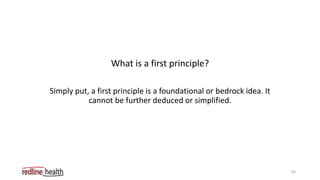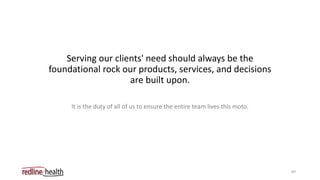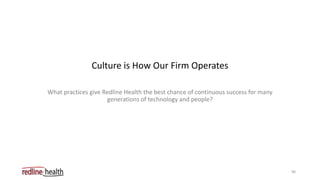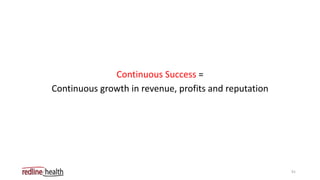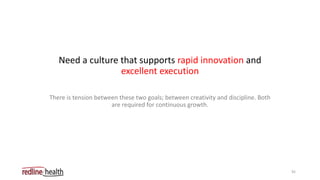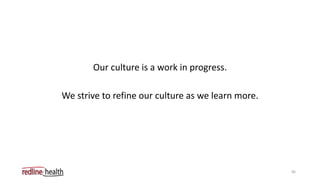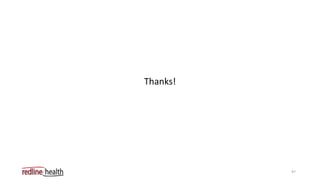Culture deck
- 1. culture deck
- 2. 2 Special Thanks to Netflix and Reed Hastings For the inspiration to put this out there and the slides to borrow (steal) from.
- 3. 3 Culture: What gives Redline Health the best chance of continuous success for many generations of technology and people?
- 4. Why have a “culture” deck? • Provide transparency to new Agents • Promote clarity of company values • Enforce our own social responsibility to maintain and uphold them to the benefit of both our clients and partners 4
- 5. Aspects of our Culture 5 • Values are what we Value • High Performance • Freedom & Responsibility • Context, not Control • Highly Aligned, Loosely Coupled • First Principal Mentality
- 6. Values 6
- 7. 7 Lots of companies have nice sounding value statements
- 8. Enron had a nice sounding Value Statement with 4 values • Integrity • Communication • Respect • Excellence 8
- 9. 9 The real company values, as opposed to the nice- sounding values, are shown by who gets rewarded, promoted, or let go
- 10. 10 Company values are the behaviors and skills that we particularly value in fellow employees
- 11. 11 We particularly VALUE in our colleagues these Behaviors and Skills…
- 12. Judgment You make wise decisions (people, technical, business, and creative) despite ambiguity You identify root causes, and get beyond treating symptoms You think strategically, and can articulate what you are, and are not, trying to do You smartly separate what must be done well now, and what can be improved later 12
- 13. Communication You listen well, instead of reacting fast, so you can better understand You are concise and articulate in speech and writing You treat people with respect independent of their status or disagreement with you You maintain calm poise in stressful situations 13
- 14. Impact You accomplish amazing amounts of important work You demonstrate consistently strong performance so colleagues can rely upon you You focus on great results rather than on process You exhibit bias-to-action, and avoid analysis-paralysis 14
- 15. Curiosity You learn rapidly and eagerly You seek to understand our strategy, market, clients, and partners You are broadly knowledgeable about business, technology and health care You contribute effectively outside of your specialty 15
- 16. Innovation You re-conceptualize issues to discover practical solutions to hard problems You challenge prevailing assumptions when warranted, and suggest better approaches You create new ideas that prove useful You keep us nimble by minimizing complexity and finding time to simplify 16
- 17. Courage You say what you think, even if it is controversial You make tough decisions without excessive agonizing You take smart risks You question actions inconsistent with our values 17
- 18. Passion You inspire others with your thirst for excellence You care intensely about Redline Health’s success You celebrate wins You are tenacious 18
- 19. Honesty You are known for candor and directness You are non-political when you disagree with others You only say things about fellow employees you will say to their face You are quick to admit mistakes 19
- 20. Selflessness You seek what is best for Redline Health, rather than best for yourself or your group You are ego-less when searching for the best ideas You make time to help colleagues You share information openly and proactively 20
- 21. 21 We urge to work with people who embody these values
- 22. 22 “You question actions inconsistent with our values” Part of the Courage Value Akin to: “I will not lie, cheat, steal, nor tolerate those who do” All of us are responsible for value consistency
- 23. 23 We strive to uphold these values in our daily routines and enforce them throughout our business (hiring, reviews, exits, and promotions)
- 24. Performance 24
- 25. 25 Imagine if every person at Redline Health is someone you respect and learn from…
- 26. 26 Great Workplace is Stunning Colleagues Great workplace is not daycare, espresso, health benefits, sushi lunches, nice offices, or big compensation, and we only do those that are efficient at attracting stunning colleagues
- 27. 27 We are a TEAM, not a family We are like a pro sports team, not a kid’s recreational team Coaches’ job at every level of Redline Health to hire, develop and cut smartly, so we have stars in every position
- 28. 28 The Keeper Test Leaders Use: Which of my people, if they told me they were leaving in two months for a similar position at a peer company, would I fight hard to keep at Redline Health?
- 29. 29 Honestly Always To avoid surprises, you should periodically ask your leader: “If I told you I were leaving, how hard would you work to change my mind to stay at Redline Health?”
- 30. 30 Isn’t Loyalty GOOD? What about Hard Workers? What about Brilliant Jerks?
- 31. Loyalty is Good • Loyalty is a good stabilizer • People who have been stars for us, and hit a bad patch, get a near term pass because we think they are likely to become stars for us again • We want the same: if Redline Health hits a temporary bad patch, we want people to stick with us • But unlimited loyalty to a shrinking firm, or to an ineffective employee, is not what we are about 31
- 32. Hard Work – Not Directly Relevant • It’s about effectiveness – not effort – even though effectiveness is harder to assess than effort • We don’t measure people by how many evenings or weekends they are working • We do try to measure people by how much, how quickly and how well they get work done and drive results – especially under a deadline 32
- 33. Brilliant Jerks • Some companies tolerate them • For us, the cost to teamwork is too high • Diverse styles are fine, as long as the person embodies our core values 33
- 34. 34 Why do we care about high performance? In procedural work, the best are 2x better than the average. In creative work, the best are 10x better than average, so we place a huge premium on creating effective teams of the best
- 35. 35 Why do we care about high performance? Great Workplace is Stunning Colleagues
- 37. The Rare Responsible Person • Self motivating • Self aware • Self disciplined • Self improving • Acts like a leader • Doesn’t wait to be told what to do • Never feels “that’s not my job” • Picks up the trash lying on the floor • Behaves like an owner 37
- 38. 38 Responsible people Thrive on Freedom, and are Worthy of Freedom
- 39. 39 Our model is to increase employee freedom as we grow, rather than limit it, to continue to attract and nourish innovative people, so we have a better chance of long-term continued success
- 40. 40 Most companies curtail freedom as they grow to avoid errors (sounds pretty good to avoid errors)
- 41. Strong Near-Term Outcome • A highly-successful process-driven company • With leading share in its market • Minimal thinking required • Few mistakes made – very efficient • Few curious innovator-mavericks remain • Very optimized processes for its existing market 41
- 42. Then the Market Shifts... • Market shifts due to new technologies or new competitors or new business models • Company is unable to adapt quickly because the employees are extremely good at following the existing processes, process adherence is the value system • Company generally grinds painfully into irrelevance, due to inability to respond to the market shift 42
- 43. Seems Like Three Bad Options 1. Stay creative by staying small 2. Try to avoid rules as you grow, suffer chaos 3. Use process as you grow to drive efficient execution of current model, but cripple creativity, innovation, flexibility, and the ability to thrive when market inevitably shifts 43
- 44. A Fourth Option • Avoid chaos as you grow with Ever More High Performance People – not with rules • Then you can continue to run informally with self-discipline and avoid chaos • The run informally part is what enables and attracts creativity 44
- 45. 45 The Key Increase Talent Density Faster Than Complexity Grows
- 46. Increase Talent Density • Top of market compensation • Attract HIGH-Value people through freedom to make impact • Be demanding about high performance culture 46
- 47. Minimize Complexity Growth • Few big products vs many small ones • Eliminate distracting complexity (barnacles) • Value simplicity 47
- 48. 48 With the Right People, Instead of a Culture of Process Adherence, A Culture of Freedom and Responsibility, Innovation and Self-Discipline
- 49. 49 Is Freedom Absolute? Are all rules & processes bad?
- 50. 50 Freedom is not absolute. Like "free speech" there are some limited exceptions to "freedom at work"
- 51. Two Types of Necessary Rules 1. Prevent irrevocable disaster • Ex. Financials produced are wrong • Ex. Hackers steal our customer's credit card information 2. Moral, Ethical, Legal issues • Ex. Dishonesty, harassment are intolerable 51
- 52. "Good" vs "Bad" Processes • "Good" processes help talented people get more done Spend within budget each quarter to avoid coordinating every spending decision across departments Regularly scheduled strategy and context meetings • "Bad" processes try to prevent recoverable mistakes 3 people to sign off on banner ad or creative Permission needed to hang poster on wall Multi-level approval process for projects Get 10 people to interview each candidate 52
- 53. Rule Creep • "Bad" processes tend to creep in - Preventing errors just sounds so good • We try to get rid of rules when we can, to reinforce the point 53
- 54. 54 Example Netflix Vacation Policy and Tracking Until 2004, Netflix maintained a standard N days per year policy Yes, we left this example straight from Netflix
- 55. 55 Meanwhile... Most employees were working online some nights and weekends, responding to emails at odd hours, and taking an afternoon now and then for personal time
- 56. 56 One Netflix employee pointed out... We don't track hours worked per day or per week, so why are we tracking day of vacation per year?
- 57. 57 Netflix realized... They should focus on what people get done, not how many hours or days worked. Just as they didn't have a 9-5 policy, they didn't need a vacation policy.
- 58. 58 Redline Health maintains a similar policy with all employees and contractors We want results for our business and our clients more than anything else.
- 59. 59 Current Netflix Vacation Policy "there is no policy or tracking" "There is also no clothing policy at Netflix, but no one has come to work naked lately." - Patty McCord, 2004
- 60. 60 Another example of Freedom & Responsibility...
- 61. 61 Most companies have complex policies around what you can expense, how you travel, what gifts you can accept, etc. Plus they have whole departments to verify compliance with these policies
- 62. 62 Redline Health's Policy for Expensing, Entertainment, Travel, and Gifts: "Act in Redline Health's Best Interests" In accordance with the law...but only 6 words long
- 63. "Acting in Redline Health's Best Interests" Generally Means 1. Expense only what you would otherwise not spend, and is worthwhile for work 2. Travel as you would if it were your own money 3. Disclose non-trivial vendor gifts 4. Take from Redline Health only when it is inefficient to not take, and inconsequential "taking" means, for example, printing personal documents at work, or making personal calls on a work phone: inconsequential and inefficient to avoid 63
- 64. 64 Summary of Freedom & Responsibility: As We Grow, Minimize Rules Inhibit Chaos with Ever More High Performance People Flexibility is More Important than Efficiency in the Long Term
- 65. Context 65
- 66. “If you want to build a ship, don’t drum up the people to gather wood, divide the work, and give orders. Instead, teach them to yearn for the vast and endless sea.” -Antoin De Saint-Exupery, Author of The Little Prince *translation uses “people” instead of “men” to modernize 66
- 67. 67 The best Leaders figure out how to get great outcomes by setting the appropriate context, rather than by trying to control their people
- 68. Context, not Control Context • Strategy • Metrics • Assumptions • Objectives • Clearly-defined roles • Knowledge of the stakes • Transparency around decision making Control • Top-down decision making • Management approval • Committees • Planning and process valued more than results 68
- 69. Exceptions • Control can be important in an emergency - No time to take long-term capacity-building view • Control can be important when someone is still learning their area - Takes time to pick up necessary context • Control can be important when you have the wrong person in the role - Temporarily, no doubt 69
- 70. 70 Leaders: when one of your talented people does something dumb, don't blame them. Instead, ask yourself what context you failed to set.
- 71. 71 When you are tempted to control your people, ask yourself what context you could set instead. Are you articulating and inspiring enough about goals and strategies?
- 72. Good Context • Linked to company/functional goals • Relative priority (how important/how time sensitive) Critical (needs to happen now), or... Nice to have (when you can get to it) • Level of precision and refinement No errors (credit card handling, health info, etc.), or... Pretty good/can correct errors (website), or... Rough (experimental) • Key stakeholders • Key metrics/definition of success 72
- 73. 73 Why managing through Context? High performance people will do better work if they understand the context.
- 74. 74 Investing in Context This is why we do new employee orientation, and why we are so open internally about strategies and results.
- 75. Highly Aligned, Loosely Coupled 75
- 76. Three Models of Corporate Teamwork 1. Tightly-Coupled Monolith 2. Independent Silos 3. Highly Aligned, Loosely Coupled 76
- 77. Tightly-Coupled Monolith • Senior management reviews and approves nearly all tactics • Lots of x-departmental buy-in meetings • Keeping other groups in agreement has equal precedence with pleasing clients • Mavericks get exhausted trying to innovate • Highly coordinated through centralization, but very slow, and slowness increases with size 77
- 78. Independent Silos • Each group executes on their objectives with little coordination • Work that requires coordination suffers • Alienation and suspicion between departments • Only works well when areas are independent - Ex. GE: aircraft engines and Universal Studios 78
- 79. The Redline Health Choice 1. Tightly-Coupled Monolith 2. Independent Silos 3. Highly Aligned, Loosely Coupled 79
- 80. Highly Aligned, Loosely Coupled • Highly Aligned Strategy and goals are clear, specific, broadly understood Team interactions are on strategy and goals rather than tactics Requires large investment in management time to be transparent and articulate and perceptive and open • Loosely Coupled Minimal cross-functional meetings except to get aligned on goals and strategy Trust between groups on tactics without previewing/approving each one – groups can move fast Leaders reaching out proactively for ad-hoc coordination and perspective as appropriate Occasional post-mortems on tactics necessary to increase alignment 80
- 81. 81 Highly Aligned, Loosely Coupled teamwork effectiveness is dependent upon high performance people and good context Goal is to be BIG and FAST and FLEXIBLE
- 83. 83 What is a first principle? Simply put, a first principle is a foundational or bedrock idea. It cannot be further deduced or simplified.
- 84. 84 For our purposes, our first principle is our WHY Why do we exist in business?
- 85. 85 We are here for our clients
- 86. 86 When Pam started Redline Health in 2005, there were no other health insurance agents in Siloam Springs, AR. NONE. She was determined to provide a client-centric agency for her community to rely on.
- 87. 87 Since then, our drive has been clear: SERVE our CLIENTS
- 88. 88 If a product or service serves our client base more effectively, we pursue it. If a product or service hinders our clients, we move away from it.
- 89. 89 Serving our clients' need should always be the foundational rock our products, services, and decisions are built upon. It is the duty of all of us to ensure the entire team lives this moto.
- 90. 90 Culture is How Our Firm Operates What practices give Redline Health the best chance of continuous success for many generations of technology and people?
- 91. 91 Continuous Success = Continuous growth in revenue, profits and reputation
- 92. 92 Need a culture that supports rapid innovation and excellent execution There is tension between these two goals; between creativity and discipline. Both are required for continuous growth.
- 93. 93 Need a culture that supports effective teamwork of high-performance people High performance people and effective teamwork can be in tension also – stars have strong opinions
- 94. 94 Need a culture that avoids the rigidity, politics, mediocrity, and complacency that infects most organizations as they grow
- 95. 95 This slide deck is our current best thinking about maximizing our likelihood of continuous success
- 96. 96 Our culture is a work in progress. We strive to refine our culture as we learn more.
- 97. 97 Thanks!

